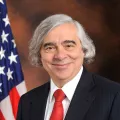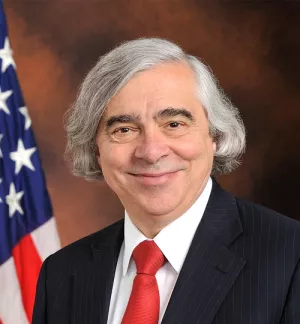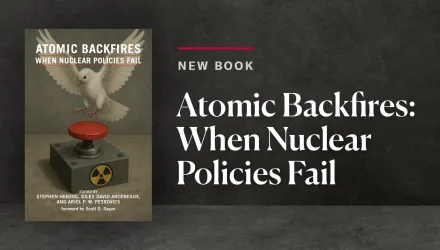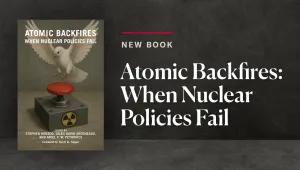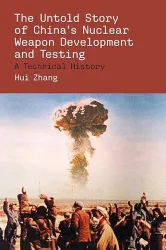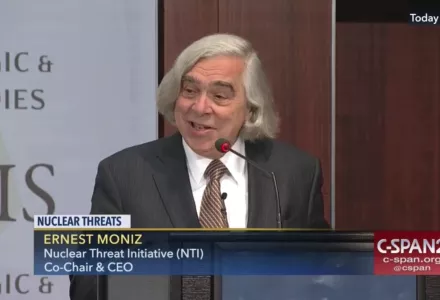
Transcript of Speech at Center for Strategic and International Studies
Thank you, John. I appreciate the invitation to join you at CSIS, an extraordinarily effective and respected organization here in Washington and around the world. And of course, CSIS has very close ties to Sam Nunn, a trailblazer and leader in nuclear security as well as a great friend and colleague. I now have the privilege of partnering with him on the urgent work of reducing global security risks at the Nuclear Threat Initiative, which he founded in 2001 along with Ted Turner. Sam is an extraordinary source of wisdom.
December 2017 marked the 75th anniversary of Enrico Fermi's first controlled nuclear chain reaction. This launched the nuclear age and set the stage for the Manhattan Project to develop the first nuclear weapons.
From that time to the present, the two sides of the nuclear coin have been well understood. Nuclear weapons are qualitatively different from other instruments of war in their destructive power, but nuclear technology also has beneficial applications for energy production, medicine and industrial activities and products. Both sides of the coin draw upon a common technology base, and it is this dual-use character that challenges national governments and international institutions.
Managing nuclear dangers and the challenges surrounding the uses of nuclear technology has been a focus of mine for four decades, and I am committed to extending NTI’s outstanding work, along with Sam, a great staff, and the broader national security community.
If judged only by the metrics that nuclear weapons have not been used since 1945, that nuclear energy provides a sixth of global electricity, and that nuclear medicine saves countless lives, we have enjoyed peaceful uses of nuclear technology while avoiding the use of a nuclear weapon. That said, we have had too many close calls with nuclear weapons, and the number of nuclear weapons states has grown.
Today in the 21st century, we are challenged by a different nuclear age:
- Miscalculation, an accident, mistake, or catastrophic terrorism now, in my view, are the most likely catalysts of nuclear use. Even though deterrence remains paramount, it is not enough (throughout this speech, I will use the term miscalculation to refer to all three types of incidents).
- The sophistication of North Korea’s nuclear weapons program cannot be denied, exacerbating a volatile regional security environment, and weakening the nonproliferation regime—the international rules that helped us survive the 20th century.
- In more than one country, there are advocates for using or threatening to use nuclear weapons in a number of scenarios, when the goal should be to avoid nuclear weapons use. The concept of “escalate to de-escalate,” which calls for limited first use, continues to make the rounds in Moscow. And last month’s National Security Strategy expanded the role of nuclear weapons, deeming them “essential to prevent nuclear attack, non-strategic attacks, and large-scale conventional aggression.”
- 9/11 heralded an age of terrorists with global reach; unconstrained by notions of deterrence, they have stated their desire for weapons of mass destruction and disruption.
- Nuclear power and nuclear fuel cycle capabilities are or may be spreading, including in regions rife with rivalries and conflicts, in an age of remarkable access to advanced technology.
Given these new realities, we need to reexamine our strategic policies and near-term decisions on the U.S. nuclear arsenal, force posture, and doctrine. We also need to examine our response to international challenges, such as in Iran and North Korea, as well as the dangerous state of U.S.-Russian relations. We must not unnecessarily convert significant diplomatic challenges into security crises, as seems to be happening today with Iran and North Korea.
Today, I will speak about current events but also want to leave you with five broad messages:
(1) The combination of advances in technology, tensions between nation states, terrorism, and cyber dangers must challenge traditional thinking about nuclear weapons policies, the risk of nuclear weapon use, the configuration and deployment of our forces, and the priorities of our investments. Maintaining a safe, secure, and reliable deterrent is necessary in today’s world but is not sufficient. The risks of miscalculation should be at the forefront of our thinking and an important driver of our analyses.
(2) Preventing nuclear use is the core objective of our nuclear policy. Specifically, when the Nuclear Posture Review (NPR) surfaces, we need to assess its recommendations in part by considering whether they lessen the dangers of miscalculation and thereby increase stability and reduce the risk of nuclear use.
If the recently released National Security Strategy is a guide to the NPR, we could be heading in the wrong direction. Expanding the types of threats against which nuclear weapons might be used under the banner of deterrence likely will make the risks of miscalculation greater, not less. For those who argue that the U.S. needs more “useable” nuclear options to enhance deterrence, they have a high burden to explain why the present options are insufficient. The President already has options for flexibly employing the nuclear deterrent. By what logic should we stress that deploying more “useable” weapons—against the backdrop of our current, flexible nuclear capability and our conventional military capabilities that remain second to none—make it less likely that they will be used? By what logic can we count on a nuclear exchange to remain “limited?” Is the full range of cyber threats to nuclear weapons command-and-control being addressed in a way that provides confidence under scenarios with very short decision time? Are we about to join those in Russia who declare that we need to be prepared to “escalate to de-escalate?” What happens if the world’s nuclear superpowers start down this road?
(3) The United States and Russia have divergent interests in many areas. Russia's intrusion in Ukraine, its backing of the genocidal regime in Syria, and tampering with our electoral process have increased tensions between our two nations. The uncertain outcome of the Mueller investigation is also a factor. Nevertheless, we must find a way to resume a strategic relationship and regularized dialogue with Russia on matters of existential common interest, to include cyber dangers, crisis management of our conventional and nuclear forces, terrorist acquisition of nuclear materials and weapons, and more.
We do not do this as a favor to Russia. We managed to do this during the Cold War and we must find a way to do this again. To support this national security imperative, we must forge a bipartisan, joint Congress-Administration approach to security issues with Russia, especially now that last year’s sanctions legislation puts in place shared Executive Branch and Congressional decisionmaking. Sam and I have specifically recommended a liaison group of Congressional, State Department and Department of Defense leadership, similar in spirit to that formed around arms control issues during the Reagan Administration.
(4) The International Atomic Energy Agency’s 20th Century nuclear fuel safeguards architecture needs strengthening in the 21st century. The IAEA is doing a very good job in monitoring Iran’s compliance with the JCPOA, using the array of new verification tools provided by the agreement. Indeed, verification is really the heart of the JCPOA, and it does not sunset. Over time, we may be able to consider evolving the JCPOA verification regime to more nearly universal application.
(5) We must make worldwide progress in developing comprehensive, commercially based, advanced nuclear fuels services, including fuels supply, waste storage and disposition. Without this progress, additional “Irans” are likely to present themselves in the future.
Let me turn to Iran:
We are on the precipice of a new crisis in Iran if the President refuses to approve the sanctions waivers, and it’s the United States, not Iran, which fails to meet its commitments under the deal.
The Iran nuclear deal—with its 159 toughly negotiated pages of detailed constraints—puts a straitjacket on Iran’s nuclear activities that effectively blocks Iran’s path to a nuclear bomb. Discussion of the JCPOA typically misses its most important features, such as the 15-year limitation (that is, until January 2031) during which Iran can have no more than 300kg of uranium enriched up to 3.67%, and the enduring verification measures covering every stage of Iran’s nuclear activities. That is what is often missed. The real heart of the JCPOA is in its unprecedented, international verification provisions. The agreement is based on verification not trust.
It’s ironic that with the Joint Comprehensive Plan of Action, Iran has the toughest constraints on its nuclear program of any nation on the planet and the most demanding verification regime. Yet the President may take action imminently to remove these constraints with no viable alternative.
Opponents of the deal are fixated on those provisions in the deal that sunset; they underplay or simply ignore the importance of the commitments that don’t expire—a permanent prohibition on Iran having a nuclear weapon or a weaponization program, permanent adherence to the Additional Protocol with a unique time window to respond to IAEA inspection requests for undeclared sites; and the requirement to ship out all spent fuel for the life of the redesigned Arak reactor. Yet, we hear that 15 years is epsilon compared to the history of the Persian Empire. That is a fact- but entirely manufactured as an objection to the agreement. Fifteen years is a significant period in the political life of a country—and Iran demonstrated that over the last couple of weeks with widespread protests that shine light on the government’s failure to adequately serve the needs of its people.
The nuclear deal was never meant to be the end of the road in our engagement with Iran. We, along with our partners to the JCPOA, should be using this time to build on the Agreement to help shape the outcome—which so far we have done very little of as we approach, in five days, the two year mark of the Agreement implementation. Our European partners stressed this. And with the nuclear agreement in place, we can and should be taking action to address Iran’s support for terrorism and the Syrian regime and its regional proxies, their human rights record, and other troubling aspects of Iranian policy—without the complications of the nuclear issue. We should keep the spotlight on the internal failings of Iranian governance and the country’s economic situation. Indeed turning up the heat on these issues with our European and regional friends and allies is essential and reinforces the failings pointed out by the recent protests. Iran needs to respond to popular demands for more rapid modernization. With the JCPOA, Iran’s leadership cannot easily blame their governance and economic shortcomings on the U.S. and external forces. We should not give leverage to the most extreme elements in Iran by unilaterally withdrawing from the JCPOA.
We must also draw lessons from the JCPOA for broader fuel cycle considerations. As we look ahead a few years, we are likely to confront more “Iran-like” circumstances unless we can build verification enhancements to fuel cycle management and develop better solutions for fuel and waste services. Advances in technology are making weapons capabilities easier to acquire under a safeguards regime that can and should be strengthened to fully meet its purpose.
The slow but steady expansion of interest in nuclear reactors internationally, and the uncertainty surrounding the future of the U.S. nuclear power industry, are making it more important than ever to identify, incentivize and implement an approach to fuel services that reinforces key nonproliferation and nuclear security principles. Such an approach should support a reliable and economical commercial fuel market, minimize the spread of uranium enrichment capacity, and address the management of irradiated fuel in ways that don’t lead to steadily increasing inventories of separated plutonium. Most important, all these approaches must be backstopped with international safeguards and monitoring systems that take advantage of technological progress and have the political and financial resources to back them up. At NTI, we are expanding our efforts in this area, and will be seeking to work with public and private partners to operationalize such an approach so that countries can have the benefits of peaceful nuclear technologies without increasing proliferation dangers. The IAEA LEU Bank is a foundational step in that direction. The IAEA LEU Bank is a foundational step in that direction. As a CSIS commission concluded several years ago, and my colleagues and I affirmed and expanded on last year, a diminishing American nuclear technology supply chain is a national security concern both for our standing in maintaining and expanding stringent nonproliferation norms and for meeting our own national security requirements.
North Korea
While the threat from the North has been growing, the President’s war of words has managed to unsettle our allies and alarm the rest of world. He is blurring the historic recognition that nuclear weapons have destructive power of a different order of magnitude than the most powerful conventional weapons. Kim Jong-un has now taken the diplomatic initiative with his outreach to South Korea and Pyongyang’s participation in the upcoming winter Olympics.
We have been living for some time with the threat of a nuclear North Korea, one that could strike U.S. allies and our forces in the Asia-Pacific region. Under Kim Jong-un, the nuclear and missile threat has become more acute as North Korea has systematically advanced its nuclear and missile technology.
There would be a significant benefit to U.S. security and a reduction in regional tensions if we can convince the North to pause and then forgo any further testing of nuclear weapons and long-range ballistic missiles. There is not a long time to capture these benefits.
More likely than not, achieving that outcome will require direct talks with the North Koreans on the path to negotiations. Whether there is now an opening for such talks is not clear. Some believe Kim Jong-Un’s New Year’s Day claim that the “power and reliability of [nuclear warheads and ballistic missiles] have already been proved to the full” opens the door to a freeze on nuclear and long-range ballistic missile tests. We should find a way to probe the North Koreans on that point, and exploit that opening if in fact there is one.
It is also imperative that we focus now on additional steps to reduce the risks of miscalculation on the Korean Peninsula, including first and foremost the risk of nuclear use but also use of devastating conventional forces on both sides of the 38th parallel. Unlike in Iran, where it made sense to keep the negotiations confined to the nuclear program in order to prevent nuclear weapons development, negotiations with Pyongyang must address broader issues beyond their declared nuclear deterrent. For talks to succeed with North Korea, the United States and China must first share a vision of the ultimate goal – the political, economic and security arrangements that can form the foundation of a more stable Korean Peninsula. That shared vision with Beijing must be built on a strong framework of consultations between the United States, South Korea and Japan, and other key parties, including Russia. We must be prepared to engage Beijing on its concerns. For example, reunification of the Korean Peninsula is not an obtainable goal for the foreseeable future, and the future regional posture of the US military forces is a critical piece of the puzzle. There is little public evidence that sufficiently encompassing discussions have taken place.
On miscalculation
One of the hallmarks of the current nuclear era is the stark reality that an accident, mistake or miscalculation – rather than forethought – is the most likely catalyst to nuclear catastrophe.
The stability that characterized the Cold War was always precarious – and it is more so today. Today’s nuclear world includes a growing number of nations with nuclear technology, including in volatile regions, expanding cyberattacks on critical infrastructure and the continuing threat of nuclear terrorism—all of which can increase the risk of miscalculation and nuclear use triggered by a fateful error.
The dangerous possibility of miscalculation by one of many nuclear-capable actors is all too real. Adversarial geopolitics is one pathway to a nuclear mistake.
U.S.-Russia bilateral relations—where Washington and Moscow still possess over 90-percent of global nuclear inventories—remain largely frozen following Moscow’s meddling in U.S. elections and resulting sanctions. The geopolitics of the Euro-Atlantic region remains tense in the wake of Russia’s intervention in Ukraine and Syria and Moscow’s ongoing information war, with new lines being drawn, and new military forces and capabilities being deployed in close proximity.
Transparency into Russian nuclear forces and operations now takes place almost exclusively in the context of the new START Treaty, which needs to be extended. We lack adequate military to military communications and have curtailed tools for crisis management- and basic dialogue that has served us well in the past is now limited. Mistrust has grown in these four years since the Ukraine incursions and so has the risk of miscalculation – on both sides. Those of us who had roles as stewards of our nuclear deterrent know well how hard we worked -on both sides- to guard against accident or mistakes. Both sides were skilled and practiced, but too often we were lucky. Without the crisis management tool-kit we will have to be more than lucky going forward.
The risk of miscalculation is not limited to the United States and Russia. The geopolitics encompassing the Korean peninsula now include a nuclear-armed North Korea. The political divides between nuclear armed states India and Pakistan persist as a nuclear flashpoint, exacerbated by the deployment of battlefield nuclear weapons. The risks of terrorism and loose nukes remain as a global concern as well.
Magnifying the risks of a nuclear mistake in each of these regions is the emergence of cyber and other technology threats to strategic warning systems and nuclear command and control. Issues surrounding decision time and the command and control of nuclear forces—which have persisted between Washington and Moscow during and after the Cold War—are more acute, particularly with little communication or cooperation between U.S. and Russian military leaders. The same is true in other regions, where political and military dialogue is either halting, fragile or completely absent.
We can all come up with our most feared cyber and technology related scenarios, which could lead to miscalculation. For example in the cyber world:
- A cyber related disruption to early warning systems
- A cyber attack on vital communications – between officials, between operators and nuclear systems, and/or between international counterparts – in a nuclear related crisis
- The introduction of malware or malicious code into nuclear weapons and associated systems through the supply chain
- A mistake in attribution of a cyber attack – the wrong return address
- We can also think through frightening scenarios for miscalculation and escalation resulting from limited nuclear use policies, a war of words invoking nuclear threats and a misinterpretation of intentions, or the employment of conventional forces against “strategic” assets.
While some people may dismiss the growing threats and risks from cyber attacks and their implications for miscalculation, I commend to you two excellent studies over a period of four years by the Defense Science Board. I draw my observations only from the unclassified portions of the reports, and I have not seen the classified portions. We can, however, intuit what they must say.
The 2013 DSB task force was asked to review and make recommendations to improve the resilience of DOD systems to cyber-attacks and to develop a set of metrics that the Pentagon could use to track progress and shape investment priorities. It concluded that "the cyber threat is serious and that the United States cannot be confident that our critical information technology (IT) systems will work under attack from a sophisticated and well-resourced opponent utilizing cyber capabilities in combination with their military and intelligence capabilities (a full spectrum adversary). “
The first of two recommendations called for “immediate action to assess and assure national leadership that the current nuclear deterrent is also survivable against the full spectrum of cyber threats.”
In January 2017 the second study went further and recommended that the Pentagon undertake a series of initiatives, including planning and conducting tailored deterrence campaigns; creating a cyber resilient "thin line" of key US nuclear and non-nuclear strike systems, and enhancing foundational capabilities to enhance US cyber resilience, including greater attribution capabilities.
While the unclassified report does not explicitly say so, its recommendations must rest on the conclusion that the contemporary cyber threat is of a character that special measures must be taken as a matter of the highest priority to protect a select limited set of nuclear and other strike capabilities. The implication of this statement is that the DSB cannot assure national leadership that the deterrent and the command and control system will work as designed and without compromise. And if we can't assure our leaders of this, how can any less capable Nation State do so? The significance of that for strategic stability, as we have known it, is grave. Just as compelling are the risks of subnational actors or terrorists acquiring the means to simulate attacks or compromise communications. The perils of false warnings of attacks - or disguised or false flag attribution - should be obvious and frightening to us all.
On NPR and tests to judge it by:
Miscalculation, as a possible instigation for nuclear weapons use, needs to be in the forefront of our thinking about nuclear weapons policy, force posture and modernization priorities. This is one lens through which we need to evaluate the new Nuclear Posture Review expected in the coming weeks, as well as issues concerning the role of nuclear weapons in our national security strategy. A clear example of the different way of thinking about this is the prompt launch status of ICBMs. This issue looks differently through the miscalculation lens than through the deterrence lens.
The United States should structure and posture its nuclear forces to deter any nation from attacking us or our allies with a nuclear weapon. The emphasis should be on safe, secure, credible and survivable nuclear forces that reduce, not increase, incentives for nuclear use—and reduce the risk of an accidental or unauthorized launch of a nuclear missile. We also need to ensure that our nuclear weapons are safe from instability and theft, so that they are never used against us or our allies.
There has been much public discussion about equipping U.S. nuclear forces with greater “flexibility” or increased “adaptability,” which could be interpreted by adversaries as making nuclear weapons more “usable.” In this context, the Nuclear Posture Review must be strenuously tested against two clear measures: (1) will they increase the risk of nuclear use, by the United States or any potential nuclear adversary; and (2) will they encourage or discourage similar nuclear plans or policies in other nations that now possess nuclear weapons, or increase incentives for other states to acquire nuclear weapons?
As Congress examines the administration’s Nuclear Posture Review and budget request for nuclear modernization, it must recognize the increasing risk of nuclear use by accident, mistake or miscalculation—which is a much more likely path to nuclear war than any adversary underestimating the strength of our conventional and nuclear forces or our resolve.
Keeping Faith with the Vision of a World Without Nuclear Weapons
Since the Nuclear Nonproliferation Treaty entered into force, eight American presidents—five Republican and three Democratic—have reaffirmed our legal obligation to work with other nuclear weapon states to divest themselves of nuclear weapons over time. It is essential that the Nuclear Posture Review back that up with practical, concrete steps toward achieving that goal. The best way to reduce and eliminate the risk of miscalculation, and nuclear use, is to work steadily to define—and then walk- the long tortuous path to eliminating nuclear weapons.
The objective of our diplomacy with Russia and other nuclear and non-nuclear weapon states should be to re-establish as a core principle the goal of reducing the role and risks of nuclear weapons in global security policies—and as a first priority, develop specific steps that reduce the risks of blundering in to nuclear use. The United States should continue its historic support for practical, concrete steps that meet the test of increasing stability, reducing nuclear dangers, and sustaining progress toward a world ultimately free of nuclear weapons. In this context:
- We must find ways to increase warning and decision time for leaders of all nuclear weapon states, including the P-5 but also India and Pakistan—for example, by addressing prompt-launch postures. This is not a simple exercise. Technical considerations are crucial in this effort, and military leaders must be given a mandate to present workable options.
- Near-term steps should focus on securing nuclear weapons and materials, and preventing nuclear terrorism. We should work with NATO allies to see if a dedicated subset of strategic forces might even more confidently substitute for our inherently vulnerable forward deployed nuclear weapons in Europe, especially since the deployment is widely recognized as serving political not military objectives. The United States should also continue its moratorium on nuclear testing, revisit the opposition to the Comprehensive Nuclear Test Ban Treaty in light of the impressive progress in science-based stockpile stewardship and global detection of underground tests, support the preservation of the Intermediate-Range Nuclear Forces (INF) Treaty and seek extension of the New START Treaty to extend predictability and verification.
- A Comprehensive verification regime that would eventually enable a world without nuclear weapons remains to be designed. Vision is important, but this is the kind of step by step hard work that will be a focus of NTI’s work.
Concluding thoughts
Now more than ever, the United States still has a unique responsibility and imperative to lead and set the right course. The nuclear policy and posture Washington sets in the coming weeks will determine America’s path for the next years—and decisions on Russia, Iran and the DPRK potentially for decades.
There is a lot of headroom for creative diplomacy. In Isaiah’s words we must “come and reason together.”
You can hear Ernest Moniz’s speech and Q&A here.
Moniz, Ernest. “Ernest J. Moniz Addresses Global Nuclear Risks.” Center for Strategic and International Studies: cogitASIA, January 11, 2018
The full text of this publication is available via Center for Strategic and International Studies: cogitASIA.

